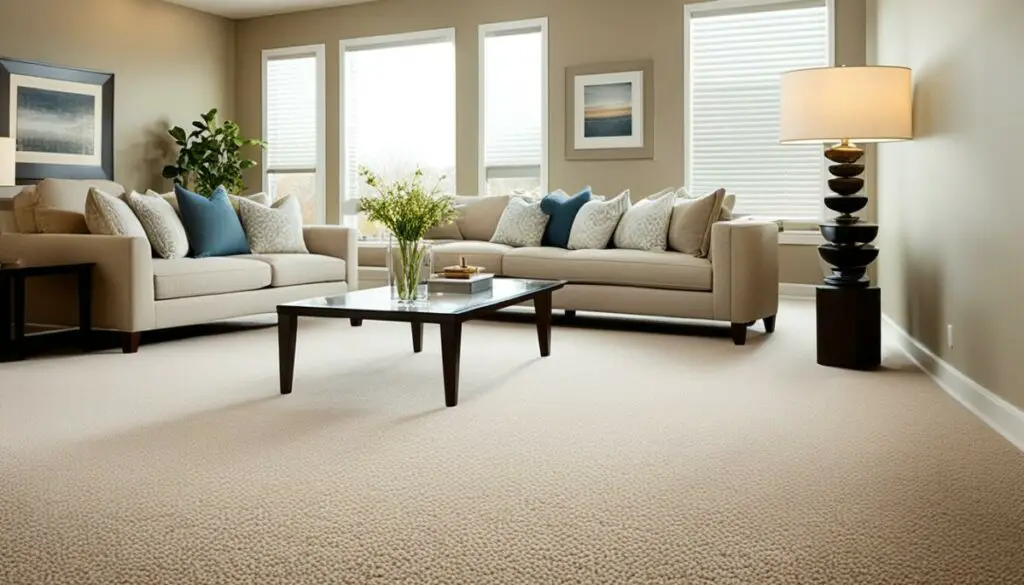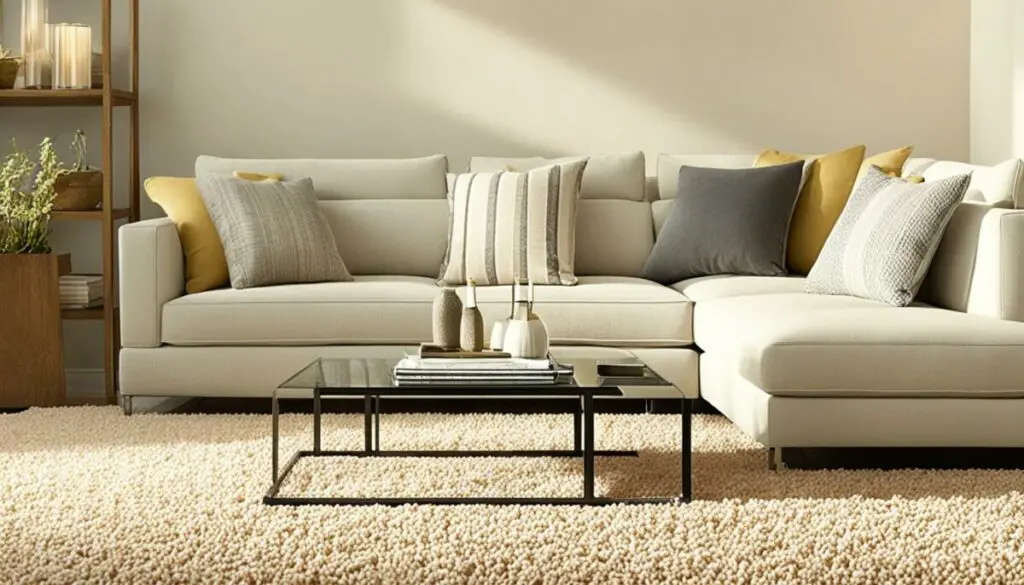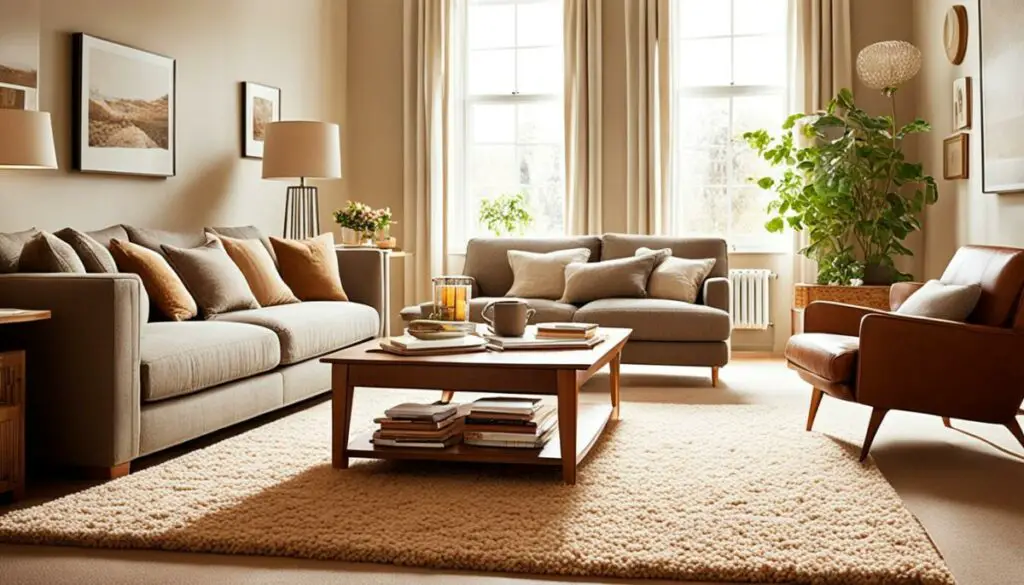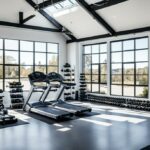Last Updated on 3 months by Francis
Are you looking for ways to make your home warmer and more energy-efficient? If so, you may be wondering if carpet can help in insulation and heat retention. In this article, we’ll explore the thermal properties of carpet and its potential benefits in keeping your rooms cozy during the colder months.
During winter, heat loss in homes can lead to increased utility bills. Floors, in particular, contribute significantly to this heat loss. Unprotected or underinsulated floors can cause as much as 15 to 25 percent heat loss in a home. The good news is that carpet flooring can act as an effective insulator, reducing heat loss through the floor and helping to maintain a stable room temperature.
Proper insulation is crucial for trapping air and retaining heat in a home. Just like humans, houses lose most of their heat through the top of their heads (roofs) and the bottoms of their feet (floors). Carpet can play a vital role in addressing the heat loss through the floor, providing an additional layer of insulation and helping to keep the room warmer.
Key Takeaways:
- Carpet can act as a good insulator, reducing heat loss through the floor.
- Unprotected or underinsulated floors can cause significant heat loss in a home.
- Carpet flooring helps maintain a stable room temperature and reduces energy consumption.
- Proper insulation is crucial for trapping air and retaining heat in a home.
- Choosing the right carpet can make a significant difference in maintaining warmth during winter.
Contents
How Insulation Reduces Heat Loss in Homes
Proper insulation plays a crucial role in reducing heat loss in homes and improving energy efficiency. By trapping air and preventing its movement, insulation creates a barrier that keeps the heat inside the house.
Insulation material, such as fiberglass, foam, or cellulose, is designed to slow down the transfer of heat from warmer areas to cooler ones. This helps maintain a comfortable temperature indoors, regardless of external weather conditions.
One area in the house that contributes significantly to heat loss is the floor. An underinsulated floor can lead to substantial energy waste, with up to a quarter of a home’s warm air escaping through the floor. This not only results in discomfort but also increases heating costs.
The impact of an underinsulated floor can be effectively mitigated by using carpet as insulation. By adding a layer of carpeting over the floor, you can prevent the majority of heat loss and maintain a stable room temperature.
Carpets have thermal properties that help retain heat. The fibers of the carpet trap air, thus creating an additional barrier against heat transfer. This trapped air acts as insulation, reducing the heat loss through the floor.
Choosing a high-quality carpet with proper padding is essential for maximizing heat retention and energy efficiency. The padding acts as an extra layer of insulation, further reducing heat transfer and increasing the carpet’s ability to retain warmth.
In summary, insulation is critical for reducing heat loss in homes, and the floor is a major area where heat escapes. By using carpet as insulation, you can effectively prevent heat loss and maintain a comfortable and energy-efficient living space.
For more information on insulation and energy efficiency, consult the experts at Carpet Land. They offer a wide range of flooring options and free estimates to help you choose the right carpet for optimal insulation.
Calculating Heat Loss and Effectiveness of Carpet

When it comes to maintaining a warm and cozy home, understanding heat loss and the effectiveness of carpet insulation is essential. Professionals can calculate heat loss in homes by considering various factors like insulation, materials, and furnishings. This calculation helps homeowners make informed decisions to improve energy efficiency and reduce heating costs.
One crucial aspect of carpet’s insulation properties is its R-value. The R-value measures how well a material can resist heat transfer, with a higher R-value indicating better insulation. Carpet, when chosen appropriately, can have a significant impact on heat retention compared to other flooring options. By selecting carpet with a higher R-value, homeowners can effectively retain heat and create a more comfortable living space.
Choosing the right carpet involves considering factors such as thickness, material composition, and carpet padding. Thicker carpets generally offer better insulation, trapping air and preventing heat from escaping through the floor. In addition, high-quality carpet padding can enhance the heat-retaining capabilities of carpeted floors, further improving energy efficiency.
Retaining heat with carpet not only helps keep rooms warm during winter but also contributes to energy savings by reducing the need for excessive heating. By minimizing heat loss through the floor, homeowners can enjoy a cozy home environment while lowering their heating bills.
Measuring Heat Loss and Carpet’s Impact
Heat loss can be measured through various techniques, including thermal imaging and energy audits conducted by professionals. These methods provide insights into the effectiveness of insulation and identify areas where improvements can be made.
When it comes to carpet, its insulation capabilities are best evaluated through its R-value, which can vary depending on factors such as carpet material, thickness, and density. The higher the R-value, the more effectively the carpet can retain heat and minimize energy loss.
It’s important to note that while carpet can play a significant role in reducing heat loss, other factors like proper insulation of walls, ceilings, and windows also contribute to energy efficiency. Combining effective carpet insulation with overall home insulation measures can yield the best results in terms of heat retention and energy savings.
To illustrate the impact of carpet insulation, consider the following table:
| Flooring Type | Average R-Value |
|---|---|
| Carpet | 2.5 |
| Hardwood | 0.5 |
| Laminate | 0.3 |
| Tile | 0.6 |
| Concrete | 0.1 |
The table above highlights the significant difference in R-values between carpet and other flooring types. Carpet’s R-value of 2.5 is considerably higher than hardwood, laminate, tile, and concrete. This means that choosing carpet as a flooring option can provide homeowners with superior heat retention capabilities and improved energy efficiency.
Choosing the Right Carpet for Maximum Insulation
When selecting carpet for insulation purposes, it’s important to consider both its thermal properties and personal preferences. Factors to keep in mind include:
- The R-value: Opt for carpets with higher R-values for better insulation.
- Material: Different materials have varying insulation properties. Wool carpets, for example, have excellent heat retention capabilities.
- Thickness: Thicker carpets offer better insulation and provide a more comfortable surface to walk on.
- Carpet Padding: High-quality carpet padding enhances insulation and prolongs the lifespan of the carpet.
By considering these factors and consulting with flooring experts, homeowners can choose the right carpet that perfectly balances warmth, comfort, and energy efficiency.
Carpet Padding and Heat Retention

When it comes to building or updating a home, carpet padding is often overlooked. However, its importance should not be underestimated. Not only does high-quality carpet padding reduce wear and tear on the carpet, but it also offers a range of other benefits. It helps to reduce noise transmission, provides comfort underfoot, and protects the structure from spills.
One of the most significant advantages of carpet padding is its impact on insulation. A good carpet pad can double the heat-retaining capabilities of the flooring, contributing to improved insulation and energy efficiency. By adding an extra layer of padding beneath the carpet, it helps to trap air and prevent heat from escaping through the floor.
Additionally, carpet padding acts as a barrier, reducing the heat transfer between the floor and the room. This makes it especially beneficial for rooms with colder floors, such as basements or rooms with concrete flooring. By retaining heat and providing insulation, carpet padding ensures a more comfortable living space and can lead to significant energy savings.
Investing in high-quality carpet padding is essential for maximizing the energy-saving potential of carpeted floors. Not only does it enhance the overall insulation of the home, but it also helps to create a cozy and comfortable environment. By reducing heat loss and improving energy efficiency, carpet padding is a valuable addition to any home.
| Benefits of Carpet Padding |
|---|
| Reduces wear and tear on the carpet |
| Reduces noise transmission |
| Provides comfort underfoot |
| Protects the structure from spills |
| Improves insulation and energy efficiency |
| Traps air and prevents heat loss |
The Feeling of Warmth and Coziness

Carpet plays a crucial role in creating a warm and cozy atmosphere in your home. It provides a soft and inviting surface that contributes to a sense of warmth regardless of the actual temperature. Walking on a cold floor can be unpleasant and chilling, but with carpet underfoot, you can experience a comforting and cozy feeling.
Not only does carpet provide physical comfort by offering a cushiony surface, but it also creates a cozy ambiance that can make your space feel more inviting. The plushness and warmth of carpeted floors can enhance the overall comfort and coziness of a room, making it an ideal choice for bedrooms, living rooms, and other areas where relaxation is paramount.
One of the significant advantages of carpet is its ability to help reduce the thermostat temperature. The insulation properties of carpet help retain heat, making rooms feel warmer even at lower temperature settings. By lowering the thermostat a few degrees, you can potentially save energy and reduce your heating costs without compromising comfort.
So, whether you’re curled up with a good book, playing with your kids on the floor, or simply enjoying the cozy ambiance of your home, carpet adds an extra layer of comfort and warmth that enhances the overall cozy feeling.
| Benefits of Carpet for Warmth and Coziness |
|---|
| Creates a soft and inviting surface |
| Enhances the overall comfort of a space |
| Makes rooms feel warmer, reducing the need for higher thermostat settings |
| Provides a cozy ambiance to your home |
Carpet as an Insulator in Summer

In addition to its benefits in maintaining warmth during winter, carpeting plays a crucial role as an insulator in the summer months. By acting as an additional layer of insulation, carpet helps limit the transfer of heat into the home and aids in retaining cool air from the cooling system. Thicker carpets with quality carpet padding provide enhanced insulation, making them ideal for warmer climates or areas with increased exposure to heat.
When the sun beats down on the roof and walls of a home, heat can penetrate through the floor. However, carpeting acts as a barrier, preventing the entry of external heat and maintaining a pleasantly cool indoor environment. By trapping cool air within the room and reducing the impact of heat from below, carpeting helps decrease air conditioning bills and contributes to energy savings.
The thermal properties of carpet create an insulation effect that hinders heat transfer and minimizes the need for excessive cooling. This can greatly benefit households situated in warm climates, where air conditioning usage is high. By reducing the cooling load on the home, carpeting allows the cooling system to operate more efficiently, thereby reducing energy consumption and cooling costs.
With its ability to prevent heat from entering the home and its potential to reduce cooling costs, carpeting offers a practical and energy-efficient flooring solution for warm climates. By investing in suitable carpet options, homeowners can create a comfortable and environmentally friendly living space throughout the year.
Carpeting for Energy Efficiency

Carpeting plays a crucial role in improving energy efficiency within a home. By adding an extra layer of insulation, carpet reduces energy transfer and minimizes the need for excessive heating or cooling. Thicker carpets and high-quality carpet padding offer enhanced insulation, resulting in long-term energy savings by lowering heating and cooling bills throughout the year.
With its ability to trap air and restrict its movement, carpet acts as an additional layer of insulation, preventing heat from escaping during the winter months and reducing the penetration of heat during the summer. This insulation benefit significantly contributes to maintaining a comfortable and consistent indoor temperature while optimizing energy consumption.
When selecting carpet for energy efficiency, it is essential to consider factors such as carpet thickness, material, and quality of carpet padding. Thicker carpets with a high-density pile provide better insulation properties, improving heat retention and energy efficiency. Additionally, high-quality carpet padding further enhances insulation and contributes to long-term energy savings.
Benefits of Carpeting for Energy Efficiency:
- Reduces energy transfer and decreases the need for excessive heating or cooling.
- Acts as an additional layer of insulation, preventing heat loss in winter and heat gain in summer.
- Improves indoor comfort by maintaining a consistent temperature.
- Optimizes energy consumption, leading to long-term cost savings on heating and cooling bills.
By choosing carpeting for energy efficiency, homeowners can create a more sustainable and comfortable living environment while enjoying the benefits of reduced energy costs. Consulting with flooring experts can help in selecting the right carpet type, thickness, and padding to achieve optimal insulation and energy efficiency in your home.
| Insulation Benefits of Carpet | Lowering Energy Bills with Carpet |
|---|---|
| ✓ Adds an extra layer of insulation | ✓ Reduces energy transfer |
| ✓ Minimizes heat loss in winter | ✓ Decreases the need for excessive heating |
| ✓ Limits heat gain in summer | ✓ Optimizes energy consumption |
| ✓ Maintains a consistent indoor temperature | ✓ Leads to long-term cost savings on heating and cooling bills |
Consult the Experts for Flooring Choices
When it comes to choosing the right flooring options for insulation and energy efficiency, consulting with flooring experts is essential. These professionals have the knowledge and experience to guide homeowners in making informed decisions based on their specific needs and preferences.
One important consideration when selecting flooring is the climate in which you live. Different climates have varying temperature ranges, humidity levels, and heating and cooling requirements. Flooring materials that work well in one climate may not be ideal for another. By consulting with experts, you can ensure that your flooring choice is suitable for your specific climate conditions.
In addition to climate considerations, lifestyle factors should also come into play when choosing flooring. If you have children or pets, durability and stain resistance may be top priorities. On the other hand, if you prefer a luxurious and soft feel underfoot, carpet may be the perfect choice for you. Experts can help you navigate through the available options and find a flooring solution that meets both your practical and aesthetic needs.
Benefits of Consulting Flooring Experts:
- Expert Advice: Flooring experts have extensive knowledge about different flooring materials, their properties, and their performance in various conditions. They can provide valuable insights and recommendations to help you make the right choice.
- Customized Solutions: Every home is unique, and experts take into account your specific requirements when suggesting flooring options. They can help you find flooring that balances energy efficiency, insulation, style, and budget.
- Maximizing Energy Efficiency: Flooring experts can guide you in selecting the best carpet for insulation. They understand the thermal properties of different carpets and can recommend options that offer superior heat retention, thus reducing your energy consumption and costs.
“Consulting with flooring experts ensures that you have access to their knowledge and expertise, allowing you to make well-informed choices and find the best flooring options for your home’s insulation needs.”
By consulting the experts, you can have peace of mind knowing that you are making the right flooring choices for optimal insulation and energy efficiency. They can help you navigate through the vast array of options available and guide you towards selecting the best carpet that will effectively retain heat in colder months while keeping your home cool during warmer seasons. With their guidance, you can create a comfortable and energy-efficient living space.
Carpet Land Omaha, Lincoln & Sioux Falls
Looking for the perfect flooring options in Omaha, Lincoln, or Sioux Falls? Look no further than Carpet Land! We offer a wide range of high-quality flooring products to meet all your needs. Whether you’re looking for carpet, hardwood, laminate, or vinyl flooring, we have it all.
At Carpet Land, we understand that choosing the right flooring can be overwhelming. That’s why we provide free estimates and consultations to help you make the best decision for your home. Our flooring experts are here to guide you through the selection process, taking into consideration your style preferences, lifestyle, and budget.
What sets Carpet Land apart is our commitment to affordability. With our buying power, we are able to offer the lowest prices on flooring products. You can find the perfect flooring for your home without breaking the bank. We believe that everyone deserves beautiful floors at affordable prices.
Our mission is to provide you with the best flooring options that not only enhance the aesthetics of your home but also provide excellent insulation and energy efficiency. With our wide range of flooring products and expert guidance, you can create a warm and cozy environment while saving on your energy bills.
Visit Carpet Land in Omaha, Lincoln, or Sioux Falls today and discover why we are the go-to destination for all your flooring needs. Contact us to schedule your free estimate and consultation. Let us help you find the perfect flooring that combines style, functionality, and affordability.
Carpet Land Locations
| Location | Contact |
|---|---|
| Omaha | (402) 333-4700 |
| Lincoln | (402) 467-6363 |
| Sioux Falls | (605) 336-5000 |
Conclusion
Carpet flooring has a significant impact on room temperature, providing insulation benefits that contribute to a warm and cozy home. By reducing heat loss through the floor and improving insulation, carpet helps maintain a stable room temperature and saves energy. The energy-saving potential of carpeted floors is not limited to winter; they also aid in insulating homes during the summer, preventing heat from entering and reducing cooling costs.
Choosing the right carpet for insulation is vital in maximizing its effectiveness. Consulting flooring experts can guide homeowners in selecting the most suitable carpet options based on climate considerations and individual preferences. Proper insulation and high-quality carpet padding further enhance carpet’s heat-retaining capabilities, ensuring optimal energy efficiency throughout the year.
With carpet’s ability to create a warm and cozy environment while saving energy, it is a practical and sustainable flooring choice for any home. Whether it’s for reducing heating bills in winter or keeping the house cool in summer, carpet flooring offers a versatile solution for year-round comfort and cost savings.
Make your home a place of comfort and energy efficiency with carpet floorings from Carpet Land. Contact us today for a free estimate and explore our wide range of flooring options to find the perfect fit for your home.
Additional Reading Materials and Contact Information
For further information on insulation and energy efficiency, the Energy.gov website offers a range of resources to help you identify and address insulation problems in your home. Whether you’re looking to improve heat retention or reduce energy consumption, these materials can provide valuable insights and guidance.
If you’re in need of expert advice on selecting the best flooring options for your home, consider reaching out to the team at Sloane’s Carpet Secret. With their expertise and knowledge, they can help you choose the right carpet and flooring solutions that meet your insulation and energy efficiency needs.
If you’re interested in exploring a wide variety of flooring options and want to schedule a free estimate, Carpet Land is here to assist you. They offer a comprehensive carpet and flooring buying guide to help you make informed decisions about your home’s insulation and energy efficiency. Contact Carpet Land today to discover their extensive range of products and services.
FAQ
Does carpet make the room warmer?
Yes, carpet acts as a good insulator, reducing heat loss through the floor and helping to maintain a stable room temperature.
How does insulation reduce heat loss in homes?
Insulation works by trapping air and preventing it from moving around, which helps to retain heat in the home. Carpet, when added to the floor, can prevent a significant amount of heat loss.
How can heat loss in homes be calculated?
Heat loss in homes can be calculated by professionals in the building industry, taking into account factors such as insulation, materials, and furnishings. The floor can contribute up to a quarter of a home’s heat loss.
How effective is carpet in retaining heat?
The effectiveness of carpet in retaining heat is measured by its R-value, which indicates how well it insulates. When chosen appropriately, carpet can retain heat better than other flooring options.
What role does carpet padding play in heat retention?
Carpet padding is crucial for insulation and can double the heat-retaining capabilities of the flooring. It also reduces wear and tear on the carpet, provides comfort underfoot, and protects the structure from spills.
Does carpet create a feeling of warmth and coziness?
Yes, carpet provides a soft and cozy feeling to a home, creating a sense of warmth regardless of the actual temperature. Walking on a cold floor can be unpleasant, but carpet underfoot contributes to a perceived warmth.
Does carpet function as an insulator in the summer as well?
Yes, carpet acts as an additional layer of insulation, limiting heat transfer into the home and helping to retain cool air from the cooling system. Thicker carpets provide better insulation.
How does carpeting contribute to overall energy efficiency?
Carpeting adds an extra layer of insulation, reducing energy transfer and decreasing the need for excessive heating or cooling. Thicker carpets and high-quality carpet padding offer better insulation and long-term energy savings.
What considerations should be made when choosing flooring options for insulation?
Consulting with flooring experts is essential, considering factors like climate, lifestyle, and preferences. Experts can guide homeowners in selecting suitable carpet options that provide optimal insulation and energy efficiency benefits.
What does Carpet Land offer in terms of flooring options?
Carpet Land offers a wide range of flooring options in Omaha, Lincoln, and Sioux Falls. They provide free estimates and consultations to help homeowners find the perfect flooring for their homes at the lowest prices.
Where can I find additional reading materials and contact information?
For additional reading materials, visit the Energy.gov website for resources on identifying insulation problems. Contact Carpet Land for their carpet and flooring buying guide and to schedule a free estimate.









